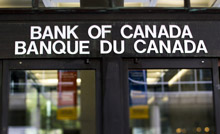
Finance Minister Jim Flaherty is signalling he may no longer be fixated on balancing the budget in four years, after the Bank of Canada and a survey of economists slashed expectations for the economy this year and next.
The finance minister came out of a meeting with private sector analysts in Ottawa on Tuesday vowing to stay the course on deficit reduction, but also to keep a wary eye on developments.
Asked directly if 2014-15 was still the target for returning to balance, as promised in the spring election, Flaherty avoided a clear date, preferring to use the more generic “medium term” for a goal.
“We have some work to do to make sure we can stay on track. I’m not going to be inflexible,” Flaherty said.
“We will stay the course, we will maintain the fiscal track so we can achieve a balanced budget in the medium term.”
He said he’ll provide more details in the fall update expected in early November.
Earlier, the Bank of Canada kept its trendsetting target rate at one per cent, while slashing its growth forecast for this year and 2012 by seven-tenths of a point to 2.1% and 1.9%.
The forecast assumes Europe deals with its financial and debt crisis, it added, otherwise it will get worse.
The bank’s crystal ball on the economic future was marginally darker than the consensus of the 15 economists surveyed by the Flaherty’s department in mid-September. Their average was for 2.2% and 2.1% growth in 2011 and 2012.
But Flaherty said there was no reason for despair — Canada is still expecting growth, unlike some European nations.
“This is not doom and gloom,” he said.
The minister said he will be “watching very carefully” the European developments, particularly if leaders can agree on a large enough bailout package for Greece and banks to appease financial markets.
Failure, he said, could result in a credit crunch touching off a second global slump — the same mechanism that started the 2008-09 Great Recession. But he didn’t believe that was likely or that Canada’s economy will fall back.
“Barring that kind of economic catastrophe coming out of Europe, the economists are of the view and I agree with them, that Canada will be looking at modest growth this year and going into next year as well, and that’s good news.”
Still, the minister said he hasn’t ruled out switching gears on his fiscal planning, including stimulus.
He said officials have been drawing up contingency plans should conditions deteriorate.
“We’re of course concerned we could have external events damage our economic growth to the point where other measures will be necessary in Canada, particular with respect to jobs. We’re watching the jobs market very carefully,” he said.
Any new stimulus measures is likely to extend the period Ottawa will need to balance the budget, as is a prolonged period of slow growth, which would lesses government tax revenues.
The Bank of Canada statement made no explicit reference to new monetary stimulus because it believes a one per cent overnight rate is already “considerable monetary stimulus.”
The two areas of strength in the economy, household and business spending, are in part the result of low borrowing costs.
The bank’s expectations, outlined in a statement accompanying the rate announcement, is that economic conditions are deteriorating across the globe, in the U.S., China and other emerging nations, and especially Europe. In fact, the bank said Europe will actually fall into a “brief” recession in the next few months.
“Although Canadian growth rebounded in the third quarter (which ended Sept. 30) with the unwinding of temporary factors, underlying economic momentum has slowed and is expected to remain modest through the middle of next year,” it added.
Low foreign demand for Canada’s exports, a high dollar, falling commodity prices, skittish markets and a more cautious consumer were among the reasons cited.
Canadian growth will remain tepid until the end of 2013, when the bank finally expects the economy to have returned to capacity. That’s more than four years after the official end of the 2008-09 recession.
Analysts said the bank’s tenor suggests Canadians could be enjoying historically low interest rates until 2013.
A tell-tale signal was that the central bank dropped a long-standing caution about interest rates eventually needing to rise, said economist Michael Gregory of BMO Capital Markets.
“The mere fact of going from this slight, vague hint of eventually tightening down the road to, ‘Hey guys, we are doing absolutely nothing for a long time,’ you necessarily then at the margin raise the risk that in the interim rates could actually fall,” he explained.
The markets immediately read the sign. The Canadian dollar dropped a quarter cent after the central bank’s statement was released at 9 a.m. ET and kept going down. The loonie closed at 98.40 US, down 1.29 cents.
Given the underutilization of the economy’s capacity and weakness abroad, the Bank of Canada said it was not particularly worried about inflation. It overlooked last Friday’s report showing consumer prices rose 3.2% in September — above the bank’s range — and that underlying inflationary pressures continue to rise.
The bank said it expects consumer price increases will soon start slowing and bottom out at around one per cent next summer before trending upwards toward the bank’s two per cent target at the end of 2013.
The bank did not even mention its long-standing worries that low rates for too long can result in irresponsible behaviour among consumers, particularly in taking on too much mortgage debt.
Some economists speculated that set the stage for the bank possibly cutting interest rates down the road, before it ever gets around to hiking them.